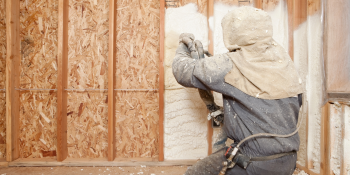Q&A Forums
Concerned about foam shrinkage Post New Topic | Post Reply
| Author | Comments |
|---|---|
|
Dan White
Posted: Oct 21, 2009 08:21 PM
|
Concerned about foam shrinkage
Howdy. I posted here a couple of times before. I had closed cell foam done to my renovated/rebuilt house this summer by someone in this forum. I posted before about a section of wall where the foam was separating from the studs about an inch. We ended up spraying canned foam in those gaps before sheetrock went up. I understand this wasn't the ideal solution, but it was a fairly limited area.Everywhere else in the house seemed to be OK best I could tell. A couple of months later we had to remove a small section of ceiling sheet rock in order to move a high hat. I happened to look through the small cut out and could see the foam in that area. This section is a slanted roof above the kitchen where we bumped the house out six feet. To my dismay I found that the foam had separated a good inch again from the studs (took photos). It wasn't like that everywhere I could see, but if a 12" square cut out reveals a foam problem, I'm really worried about what other problems are there that I don't know about. Is is possible for foam to shrink after a couple of months where it was good for a couple of weeks after spraying? The house had been wrapped in Tyvek as we thought we were going with fiberglass. Of course the roof discussed above doesn't have Tyvek - only tar paper, but will the Tyvek likely keep me from having moisture problems here in northern NJ? I'm more concerned about that than I am about losing insulation value on those sections. Thanks for any help. |
|
mason
Posted: Oct 21, 2009 09:18 PM
|
Yes, I have seen foam that has shrunk and cracks that developed months after the original installation. If the cracks extend all the way to the substrate and there is no insulation, then I would have a concern with condensation against the substrate. Tyvek will not stop humid air from the inside going into the cavity and condensing against the cold substrate. I would get a infra-red scan of the building from the inside and outside. That scan should find any areas where the foam has shrunk back. Then those areas can be identified, the foam cut back and replaced. Contact your contractor and supplier to let them know of the situation. Most will take care of the issue in a responsible manner. If you have problems, give me a call. I might be able to help. |
|
Dan White
Posted: Oct 21, 2009 11:44 PM
|
They said they were going to take infrared images when they came back for the state rebate inspection, which was a few weeks ago. I never saw anything and get the feeling they have had enough of this particular job. I still owe them a small amount of money, if that means anything. Would it be helpful for me to wait for a bit colder weather before trying to get the infrared images? There's not much of a temp gradient inside/outside right now. I'm going to ask them to come back and do the infrared. If they still read this forum they will know to call me anyway I guess. |
|
stan seidel
Posted: Nov 29, 2009 10:57 PM
|
I am having this same problem ! check out my post on this q & a forum called ( warped ceiling ) The closed cell foam product was heat lok soy from demilic. and they arent too willing to help me either. Stumpy |
|
Dan White
Posted: Nov 29, 2009 11:33 PM
|
My installer said they would do an IR scan when the weather gets a little colder. I'm not confident they will be able to find the problems, or will be able to fix them without tearing a newly finished house apart. |
|
mason
Posted: Nov 30, 2009 06:29 AM
|
An infra-red scan works pretty well in finding gaps and voids in the foam that would affect your insulation value and condensation control. |
|
Dan White
Posted: Nov 30, 2009 07:20 AM
|
But how easily can problems be fixed without tearing the house apart? |
|
mason
Posted: Dec 01, 2009 07:31 AM
|
Typically foam shrinkage is limited to less than 5% of the total foam application (based on the projects I have inspected in the last 2 years). If you can identify the areas of deficient foam, you can remove the drywall and the foam, then respray the foam and install new drywall. for example a project in Pennsyvania recently cost around $3000 to remove the drywall and the cracked foam, replace the foam and the drywall. The supplier and the contractor jointly picked up the cost of the repair. |
|
Angus McDougald
Posted: Dec 04, 2009 07:00 PM
|
I will respray if you deal with the drywall... Even though it was a former boss's job, I will do my best to fix it as I sold and sprayed your house... the supplier biobased is apparently bankrupt |
|
Dan White
Posted: Dec 04, 2009 09:03 PM
|
Let's see what comes of the scan. I would think the former boss should be responsible, but let's see if there is anything to worry about first. Thanks. |
|
Posted: Dec 05, 2009 06:58 AM
|
in a perfect world... oh yeah there is no perfect world.... i would guess that you could/would find cracks,,supposed shrinkage,,real shrinkage,,gaps and other imperfections in ANY application... just as with any product that requires human intervention to afford said application... maybe blower door pressurization with ir to help put some objective numbers on the amount of leakage. if the leakage is approaching the numbers similar to the filterglass or cellulose homes you may want to consider remediation... if you show numbers that are where a foam insulated home with subsequent air barrier should be,,,maybe you could come to some financial comprimise,,or maybe you accept it as what it is,,,about 5x better performing that what it "could be",,,even with the imperfections... as there is no perfect world,,, drove my chevy... to the levy... and the chinese... were charging admission... burma shave |
|
Dan White
Posted: Dec 05, 2009 05:39 PM
|
This house is not exactly typical of any other sprayed house. The attic (2 of them actually) has cellulose, the den and garage have original 1960 fiberglas, and the basement sills have nothing. So what blower reading should that show? Like I said originally, I have no problem with a few gaps here and there. There were lots of gaps in the living room and I ended up spraying canned foam and calling it a day. We'll see if that was a wise move when we do the IR, I guess. What I do have a problem with is whether these rather large gaps will allow condensation and potential mold. A financial agreement won't fix that, only a repair will. How well will an IR pick up gaps if done from outdoors through the roof? I ask this because the gap I saw probably can't be picked up from the inside as there is a level sheetrock ceiling separating the kitchen from the slanted roof, if that makes sense. |
|
mason
Posted: Dec 07, 2009 07:49 AM
|
You can take infra red scans from the inside of the house. The attic would be colder than the inside and would show a temperature difference where the foam gaps and voids exist. |
|
Dan White
Posted: Dec 07, 2009 06:47 PM
|
The section of roof I mentioned above is about 20' long and maybe 8' wide. It snowed a couple of inches the other day and I saw two areas or lines from the house down to the gutter where the snow was melted away. One of these lines was about where I observed the gap originally from inside the kitchen, and the other line was near the other end of the roof. It'll be interesting to see if the IR shows problems in the same area. |
|
Steven Dixon
Posted: Dec 15, 2009 07:48 PM
|
Bushka, my name is Steve Dixon and I am the Director of Sales for BioBased Insulation. I was just informed of this issue from a customer who read this thread. User 'solarbuildersgroup' incorrectly stated that our company is "bankrupt". Although we are in Chapter 11 reorganization, we are currently, and have been, continuing operations as usual throughout this entire process. We continue to stand behind the quality of our products and warranty them as we have since we began. I would like to request the opportunity to further understand and research what happened on this project (Who was the contractor/what exact product was used/when the project was sprayed/etc.). Please contact me at 800-803-5189. Solarbuildersgroup, would you please contact me at the same phone number as above with lot #'s of the product you used on this job? If you do not have that information would you please provide me with the following information. Contractor Name? Exact product used? (i.e. BioBased XXXX) Approximate purchase date of product? Thanks, SD |
|
Dan White
Posted: Dec 15, 2009 11:52 PM
|
Glad to hear from you. I'll get in touch tomorrow. |





























